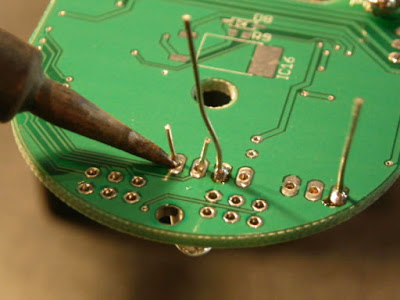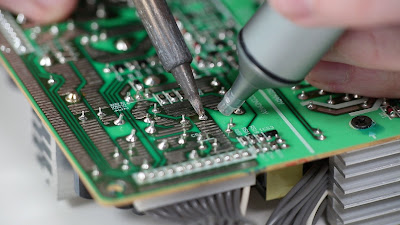An overview of ‘The desoldering process’-
Going by the word, desoldering is simply the reverse process of soldering.
Your soldering iron need not be the best one, but should be able to heat at the tip. Here’s a decent soldering iron in-case you’re lost in the various specifications available. There are many ways of going about it, the most popular ones include-
1. Plain pull-off.
If your soldering iron does the soldering work well, it would do the desoldering fair enough.
If it’s just a two legged component like an LED you could simply heat the soldered ends by touching the iron to the joint and quickly pull out the component.

2. Using a Desoldering Wick
When it comes to desoldering 3 legged components you could use a desoldering wick-a fine mesh of flux-coated, copper strands that absorbs solder when heated. All you have to do is press the Soldering iron against the joint with the wick between the two. This is by far, the oldest and most popular way of desoldering.

3. Using a Desoldering Pump
You could also simply suck out the heated solder using a desoldering pump and cleanly extract the component.

As you may be knowing, fumes released while soldering are harmful to health, and can lead to difficultly in breathing. The best way to counter the fumes is to use a fume extractor. You could buy a fume extractor online, or build one yourself using a PC fan and some carbon filter. Here’s a great project video on how to do so.

Not everything is worth desoldering or salvaging.
 |
| The SMD components |
- USB and other female connectors
- LEDs if their legs are long enough to be cut
- Useful ICs
- All types of motors (needless to say!)
- Speakers and Buzzers
- Sensors and modules (for eg. TSOPxxxx IR receivers)
- Ceramic and Film Capacitors
- Potentiometers
- Transistors
- Condenser microphones
- Coils
- Relays
- Special switches
- Heat Sinks
 |
| Film capacitors from a ‘distortion guitar pedal’ circuit |
 |
| Power Supply board from a CPU containing desolder-able components |
What to find, where?





Unknown
October 1, 2017 at 3:17 amSurface mount parts can be removed efficiently using a heat gun (hot air blower). You can find them on ebay at a very reasonale price.
To move bulk smt parts, use the hot air on the back side
Practice on a circuit borad you plan to toss or recycle.
Tools:
*A work matt, cutting board or a sheet of cardboard to prevent damage to the table or counter top.
*Bench vise (or Helping hands)
*A barbeque screwer (it keeps your fingers out of the hot air).
Hot air gun (blower)
Slowly move the hot air close to the cuircut board moving it in a circular motion to heat area you want to remove the smt/smd components.
Drug stores have pill boxes you can use as orginized storage bins.
Siddharth Kothari
October 1, 2017 at 3:36 amThanks a bunch for the insight. I have to give that a shot. All this while I've been wasting SMD components.